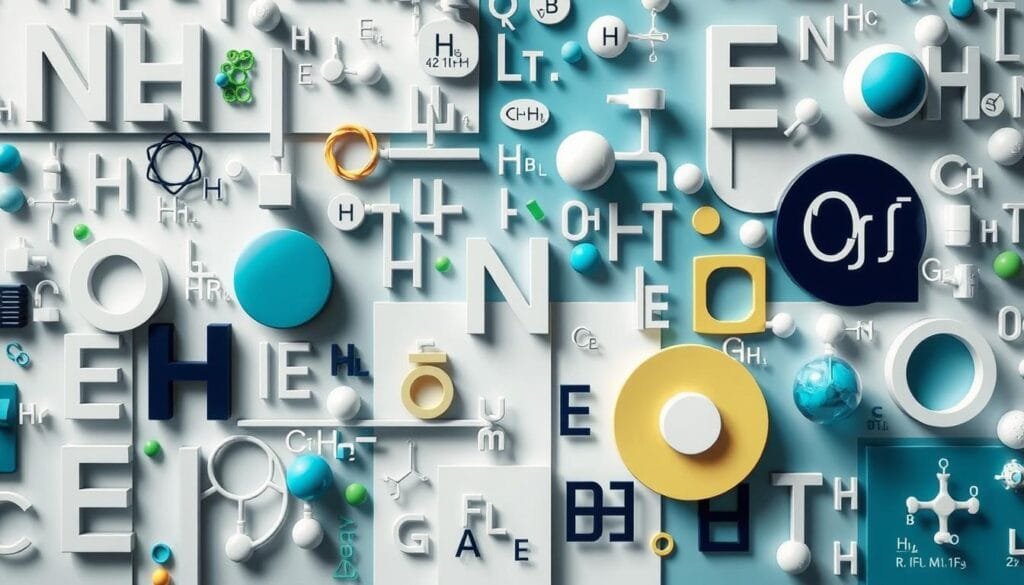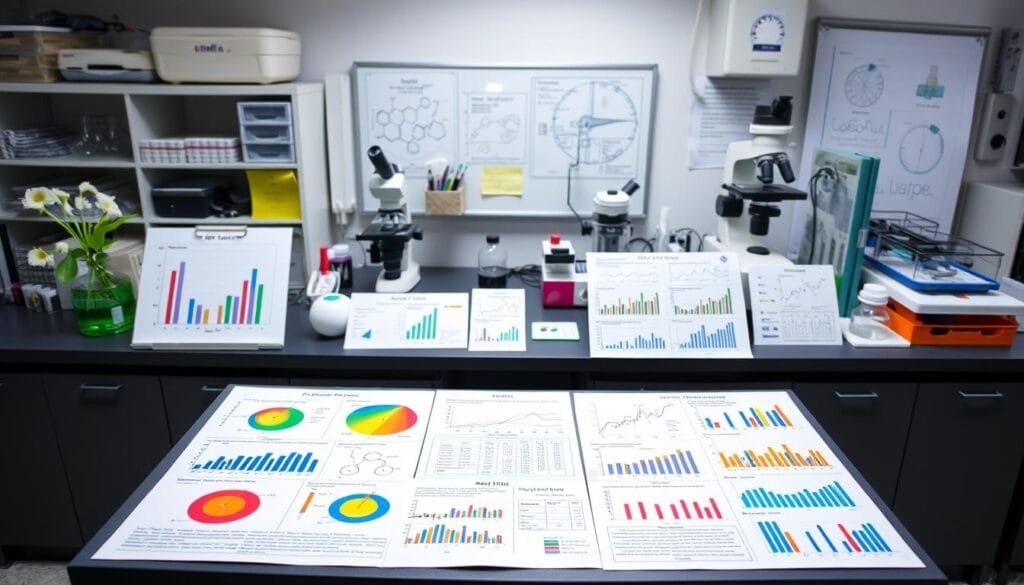The American Chemical Society (ACS) Style Guide is key for writers and editors in chemistry and related fields. Founded in 1876, the ACS has over 158,000 members. They offer this guide to help create clear scientific communications. The ACS Style Guide is special. It’s not like The Chicago Manual of Style or APA Style. It’s made for scientists. It covers scientific ethics, how to submit manuscripts, and formatting rules in detail.
Key Takeaways
- The ACS Style Guide is highly regarded in the field of chemistry for its specialized focus.
- It addresses a wide range of topics, from ethics in scientific publication to chemical structure representation.
- General formatting guidelines include 1-inch margins, 12-point Times New Roman font, and double-spacing.
- The guide offers three methods for in-text citations: superscript numbers, numbers in parentheses, and the author-date system.
- Specific reference list formatting rules include left alignment and a hanging indent.
- Figures and tables have distinct formatting requirements to ensure clarity and precision.
Understanding the ACS Style Guide
The American Chemical Society (ACS) Style Guide is crucial for chemists to share their findings. It makes sure the science is clear, precise, and consistent. This is key for understanding complex details.
History and Purpose of ACS Style
The ACS Style Guide started to help standardize chemical science documentation. Now in its third edition, it was first brought out to ensure consistency. The latest edition, the ACS Guide to Scholarly Communication, came out in 2020. The American Chemical Society has been around since 1876. It’s the biggest science society by members and upholds high standards through the guide.
Core Elements of the ACS Style Guide
The ACS Style Guide focuses on the right way to name chemicals, use abbreviations, and other chemical writing rules. It explains three ways to cite works within the text: Superscript, Italic Numbers in Parentheses, and Author-Date. Superscript and Italic Numbers are preferred for being less distracting. References can be listed by when they’re mentioned or alphabetically by author’s name. CASSI abbreviations are recommended for journal titles.
Comparing ACS Style with Other Style Guides
The ACS Style Guide is unique to the chemical sciences. It’s different from APA or Chicago because it gets into chemical naming rules and online manuscript systems. This focus makes it crucial for chemistry communication. A comparison of citation styles shows its critical role.
The ACS rules make sure chemical studies are shared accurately and consistently. They stick to ethical standards, helping scientists around the world exchange ideas smoothly. The latest version is more thorough, showing the work of a diverse team of writers and editors.
ACS Writing Style and Formatting Guidelines
The American Chemical Society (ACS) style ensures uniformity in scientific writing. It involves using a 12-point Times New Roman font and 1-inch margins. These rules make papers easier to read and help reviewers focus on the content.
General Formatting Rules
Following ACS formatting rules is key for clear scientific communication. Every page should have 1-inch margins and use a readable 12-point Times New Roman font. Such uniformity is crucial across ACS journals.
Manuscript Structure
An ACS manuscript’s structure is key to presenting research clearly. It includes sections like abstracts, introductions, and conclusions. This organization helps readers understand the research better.
Font and Spacing Standards
The ACS style requires manuscripts to be double-spaced, using the right font. This makes sections easy to distinguish. It improves clarity and visual separation.
Proper Use of Abbreviations
Using scientific abbreviations correctly is essential. It helps peers understand the discussion. The ACS Style Guide provides guidance on abbreviations. This ensures terminologies are standardized within the scientific community.

ACS guidelines offer detailed instructions for citing sources. For books, include author names, title, edition number, and publication place. Journal citations should have volume numbers and page ranges. For websites, include URLs and access dates. This ensures relevance and accuracy.
What is American Chemical Society Format?
The American Chemical Society (ACS) started in 1876 at New York University. It’s the biggest scientific group in the U.S. and a key part of the science world. The ACS citation style helps make scientific info clear and easy to track. This is vital for good science talks and keeping track of science work.

In-Text Citation Methods in ACS
The ACS Style Guide gives detailed advice on citing sources. It mentions three main ways: Superscript, Italic Numbers in Parentheses, and Author-Date. Superscript and Italic Numbers save space on the page. But, Author-Date is best when you need to highlight the publication year, like in literature reviews.
Author-Date helps readers see when something was published. It makes understanding the timeline in your research easier. These ways of citing keep your work consistent and professional.
Reference List Formatting
A well-done reference list is key for academic honesty. The ACS Style Guide suggests being consistent and accessible but isn’t super strict. The Chemical Abstract Service Source Index (CASSI) helps standardize journal titles in your list.
To make referencing easier, try MyBib’s ACS citation generator. It helps you make correct citations and references according to ACS rules.
Specific Citation Examples
Understanding correct citation examples is important. For a journal article, the pattern is:
- Author(s). Title of Article. Journal Abbreviation Year, Volume, Pagination.
For example: Smith, J.; Doe, A. The Chemistry of Nanomaterials. J. Am. Chem. Soc. 2020, 142, 1234-1240.
Knowing these examples helps your papers meet ACS standards well.
Handling Electronic Sources
Citing online sources in ACS style needs care, including dates accessed and DOIs. This is for online journal articles:
- Author(s). Title of Article. Journal Abbreviation [Online] Year, Volume, Pagination. DOI.
Example: Johnson, K.; Lee, H. The Role of Catalysts in Renewable Energy. Org. Lett. [Online] 2021, 23, 4567-4572. DOI: 10.1021/acs.orglett.1c00123.
Adding the right details makes your citations strong and reliable, following the ACS Style Guide.
Using Figures and Tables in ACS Style
In the American Chemical Society (ACS) format, presenting visuals clearly is key. Following the right rules helps keep visual information consistent. This makes everything more understandable and professional looking. Let’s look into the main rules for using figures and tables in ACS style.
Guidelines for Figures
In ACS style, each figure must be numbered in the order mentioned. Every figure needs a short caption below the image. This caption explains the figure’s content, helping readers understand without going back to the text.
The font size within figures should be slightly smaller than the text’s font. It’s also important to use consistent styles and colors across all figures. This keeps the document looking uniform.

Formatting Tables
Like figures, tables are crucial for showing complex data clearly in ACS style. Each table gets a sequential number and a descriptive title above it. This helps readers understand the table’s purpose at a glance.
Tables should fit well with the surrounding text. Using the right font size and spacing ensures tables blend with the manuscript’s style. Here’s an example of a table that follows ACS guidelines:
| Citation Method | Description |
|---|---|
| Sequential Numbering | Citations are numbered consecutively in the order they appear in the document. |
| Author Inclusion | Include up to ten authors in the reference listing; if more, list the first ten. |
| Location Details | City and state for US cities or city and province for Canadian cities; for others, provide in English. |
| Database Guidelines | Online databases are identified by unique numbers or chemical names, with home page URLs included for subscription sites. |
Following ACS guidelines for figures and tables improves your manuscript’s quality. It also makes sure your visual data is presented well and consistently. With careful planning, we can stick to the ACS style’s standards for visual data.
Conclusion
We have explored the important aspects of the American Chemical Society (ACS) format. The Summary of ACS Style Guide shows us that since 2006, the ACS Style Guide is crucial for chemists. It helps in sharing scientific findings accurately and clearly. Guidelines make sure research papers are easy to read and access worldwide.
The ACS Style Guide highlights how titles should avoid jargon and symbols. Abstracts need to summarize the study’s core in 80 to 200 words. Also, it supports various in-text citation styles. This flexibility meets the different needs of the scientific community.
When it comes to the reference list, details matter. Each citation needs enough information to find and identify sources. The ACS format sets clear rules for journals, books, electronic sources, and government documents. It ensures figures and tables clearly present data and analysis.
Final thoughts on ACS formatting include that mastering this style is key for chemists. It’s about showing commitment to scientific excellence. Following the ACS guidelines highlights a researcher’s dedication to clear communication. It helps advance the field of science.
FAQ
What is the American Chemical Society (ACS) Style Guide?
The ACS Style Guide is essential for those in chemistry and similar fields. It provides rules for writing and publishing. It covers scientific ethics, how to submit manuscripts, and formatting standards.
How does the ACS Style Guide support scientific communication?
It aims to help chemistry experts by enhancing clarity and consistency in writing. The guide emphasizes the right structure, precise language, and proper source citation. These elements are key for good scientific communication.
What distinguishes the ACS Style Guide from APA or Chicago Manual of Style?
The ACS Style Guide is specific to the chemical sciences, unlike APA or Chicago Manual. It gives detailed instruction on naming chemicals, using abbreviations, and follows conventions in chemical writing. It also guides scientists on submitting manuscripts and ethical matters.
What are the general formatting rules according to the ACS Style Guide?
The guide recommends using a 12-point Times New Roman font and 1-inch margins. Your work should be well-organized with titles and subtitles. It also advises on correct abbreviations and section layout such as abstracts, introductions, and methodologies.
How should references be formatted in ACS Style?
The ACS Style has two citation formats: superscript numbers or italic numbers in brackets. Both styles need a detailed reference list at the end with a hanging indent. This format ensures documentation is clear and well-organized.
How does ACS Style handle electronic sources?
Citing online sources requires dates of access and DOIs for lasting traceability. This keeps scientific discussions reliable and sources easy to find.
What are the guidelines for using figures in ACS Style?
Every figure should be numbered in order and include a brief caption below it. Figures must match the manuscript in style, size, and font. This keeps the document looking professional.
How should tables be formatted according to the ACS Style Guide?
Tables need a heading and should fit the manuscript’s story for better understanding. Tables and figures must look consistent with the rest of the work. This uniformity is crucial for the document’s visual appeal.
Why is adherence to the ACS Style Guide important for chemical literature?
Following the ACS Style Guide promotes uniformity in scientific publications. It makes scientific information more readable and accessible. This fosters better communication within the scientific community, benefiting global chemical literature.
